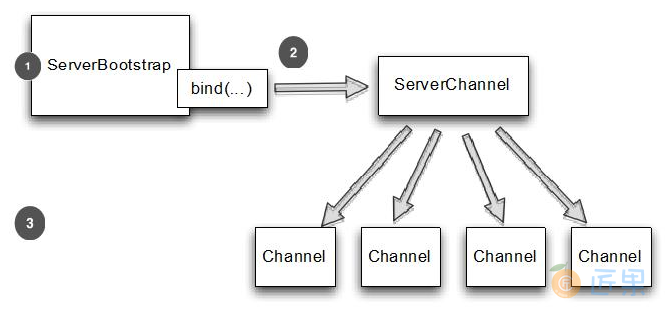服务器的引导共用了客户端引导的一些逻辑。
引导服务器的方法
下表显示了 ServerBootstrap 的方法
Table 9.2 Methods of ServerBootstrap‘
| 名称 | 描述 |
|---|---|
| group | 设置 EventLoopGroup 用于 ServerBootstrap。这个 EventLoopGroup 提供 ServerChannel 的 I/O 并且接收 Channel |
| channel channelFactory | channel() 指定 Channel 的实现类。如果管道没有提供一个默认的构造函数,你可以提供一个 ChannelFactory。 |
| localAddress | 指定 ServerChannel 实例化的类。如果不提供,将由操作系统创建一个随机的。或者,您可以使用 bind() 或 connect()指定localAddress |
| option | 指定一个 ChannelOption 来用于新创建的 ServerChannel 的 ChannelConfig 。这些选项将被设置在管道的 bind() 或 connect(),这取决于谁首先被调用。在此调用这些方法之后设置或更改 ChannelOption 是无效的。所支持 ChannelOption 取决于使用的管道类型。请参考9.6节和 ChannelConfig 的 API 文档 的 Channel 类型使用。 |
| childOption | 当管道已被接受,指定一个 ChannelOption 应用于 Channel 的 ChannelConfig。 |
| attr | 指定 ServerChannel 的属性。这些属性可以被 管道的 bind() 设置。当调用 bind() 之后,修改它们不会生效。 |
| childAttr | 应用属性到接收到的管道上。后续调用没有效果。 |
| handler | 设置添加到 ServerChannel 的 ChannelPipeline 中的 ChannelHandler。 具体详见 childHandler() 描述 |
| childHandler | 设置添加到接收到的 Channel 的 ChannelPipeline 中的 ChannelHandler。handler() 和 childHandler()之间的区别是前者是接收和处理ServerChannel,同时 childHandler() 添加处理器用于处理和接收 Channel。后者代表一个套接字绑定到一个远端。 |
| clone | 克隆 ServerBootstrap 用于连接到不同的远端,通过设置相同的原始 ServerBoostrap。 |
| bind | 绑定 ServerChannel 并且返回一个 ChannelFuture,用于 通知连接操作完成了(结果可以是成功或者失败) |
如何引导一个服务器
ServerBootstrap 中的 childHandler(), childAttr() 和 childOption() 是常用的服务器应用的操作。具体来说,ServerChannel实现负责创建子 Channel,它代表接受连接。因此 引导 ServerChannel 的 ServerBootstrap ,提供这些方法来简化接收的 Channel 对 ChannelConfig 应用设置的任务。
图9.3显示了 ServerChannel 创建 ServerBootstrap 在 bind(),后者管理大量的子 Channel。

- 当调用 bind() 后 ServerBootstrap 将创建一个新的管道,这个管道将会在绑定成功后接收子管道
- 接收新连接给每个子管道
- 接收连接的 Channel
记住 child* 的方法都是操作在子的 Channel,被 ServerChannel 管理。
清单9.4 ServerBootstrap 时会创建一个 NioServerSocketChannel实例 bind() 。这个 NioServerChannel 负责接受新连接和创建NioSocketChannel 实例。
Listing 9.4 Bootstrapping a server
NioEventLoopGroup group = new NioEventLoopGroup();
ServerBootstrap bootstrap = new ServerBootstrap(); //1
bootstrap.group(group) //2
.channel(NioServerSocketChannel.class) //3
.childHandler(new SimpleChannelInboundHandler<ByteBuf>() { //4
@Override
protected void channelRead0(ChannelHandlerContext ctx,
ByteBuf byteBuf) throws Exception {
System.out.println("Reveived data");
byteBuf.clear();
}
}
);
ChannelFuture future = bootstrap.bind(new InetSocketAddress(8080)); //5
future.addListener(new ChannelFutureListener() {
@Override
public void operationComplete(ChannelFuture channelFuture)
throws Exception {
if (channelFuture.isSuccess()) {
System.out.println("Server bound");
} else {
System.err.println("Bound attempt failed");
channelFuture.cause().printStackTrace();
}
}
}
);
- 创建要给新的 ServerBootstrap 来创建新的 SocketChannel 管道并绑定他们
- 指定 EventLoopGroup 用于从注册的 ServerChannel 中获取EventLoop 和接收到的管道
- 指定要使用的管道类
- 设置子处理器用于处理接收的管道的 I/O 和数据
- 通过配置引导来绑定管道
下一节:有时你可能需要引导客户端 Channel 从另一个 Channel。这可能发生,如果您正在编写一个代理或从其他系统需要检索数据。后一种情况是常见的,因为许多 Netty 的应用程序集成现有系统,例如 web 服务或数据库。